
Brian W
-
Posts
16 -
Joined
-
Last visited
Posts posted by Brian W
-
-
25 minutes ago, PaulEC said:
The only problem I see with a word count is that words vary so much in length. Maybe a character count (with and without spaces) would be more accurate if you want to have an idea of how much space is used?
For example a count of ten words could either be:
"a a a a a a a a a a"
or it could be
"Antidisestablishmentarianism Antidisestablishmentarianism Antidisestablishmentarianism Antidisestablishmentarianism Antidisestablishmentarianism Antidisestablishmentarianism Antidisestablishmentarianism Antidisestablishmentarianism Antidisestablishmentarianism Antidisestablishmentarianism"
😁😁😁😁😁😁😁😁😁😁
Seriously, I agree that word and character counts could sometimes be useful, but until Affinity introduces such a feature, if you really need a word count, it's easy enough to copy and paste the text into a text editor, like LibreOffice. It took about twenty seconds to find out that this post has 191 words and 1,027 character in it.
I hear what you're saying. It's 'how long is a piece of string' but when you have an industry that has historically relied on a particular way of measuring text to approximate the space required, it seems strange to ignore it.
Using a third party app to tell you something that the app you're working in is doing seems a little out of whack. Especially when you consider the amount of competing apps that can deliver what you need.
Publisher can't genuinely hope to compete with the more established apps if it's going to fall at hurdles like this and the developers are going to literally ignore industry professionals who seem to think it necessary/useful. -
I created a document in Publisher for the first time since ditching Indesign.
The idea was to recreate a previous A4 Indesign file in A5 size and in Publisher.
There are a few paragraphs of text that need editing down to fit the new size.
The Editor asked for a word count. A pretty normal request in publishing but I was so surprised that a dedicated publishing app didn't have a feature so fundamental to what we're using it for, I had to check the forum to see if I was missing something?
I am missing something... A word count facility.
I know the price of the app is so much better than Indesign and for the most part it's a joy to use. I don't expect it to have all the bells and whistles of Indesign either but when when an app of such potential ignores fundamental practices of the industry it is designed to serve (and not for any lack of prompting by industry users) you have to wonder who the developers are listening to?
Let's face it, Affinity don't market their apps to deter professionals and attract Hobbyists.
-
22 hours ago, Ulysses said:
I’ve owned Publisher from the beginning, but I’m only recently taking a more serious look at it.
I've been impressed with Publisher up until now. I was trying to lay out some text today and where Indesign gives great flexibilty with leading and letter spacing, I was expecting the same kind of operation from Publisher but unfortunately, that wasn't the case. It was all going too well. I'll get there eventually but at the moment I don't have the time to spare so It'll have to wait. ☹️
-
13 minutes ago, Ulysses said:
This is another important branch of the overall conversation about having choices, options, and working the way we want to work as creatives. 🙂
One of the reasons I left Windows was very similar to my reasons for escaping the shackles of Adobe—I wanted a different set of options available to me. Sometimes those options were in the form of specific apps I prefered to use. Other times it was about the user interface. And still other times it was more about the Mac and iOS ecosystem.
Like many companies, Corel has had to make some hard decisions about which applications they devote resources for robust development. On sheer numbers, it makes more sense for corporations like Corel to give more of those resources to Windows development, with the result that the Mac version is never fully baked and backed. It's too bad.
Thank goodness for others such as Serif! For now, I'm happy to grow along with the Affinity apps. While I have a long background in use of pixel level editors such as Photoshop and others like it, I'm rather newer to vector drawing software. Interestingly I owned CorelDraw 4, but I didn't actually use it for anything. I purchased it strictly because the CD disc came with hundreds of royalty-free assets and clipart. I wish I'd taken the time to truly learn the software way back then, but I simply didn't understand it—it was such a different concept than using pixel editors.
At any rate, here we are now nearly 2021, and it's great having this sort of access to tools that are providing new options, even as these tools get better.
It's funny that you should mention old versions of software. My father in law gave me a a Serif page layout program years ago and I didn't bother with it because it wasn't a big name. Affinity was recommended to me by someone at our local Apple store and it wasn't until I went to the website that I recognised the name 'Serif'. I was a bit skeptical at first especially when I saw the price. I took advantage of the half-price sale in May which was ridiculously cheap. Publisher is incredibly smooth and maintains high-quality image rendition in normal working format unlike Indesign where you have a trade-off of speed or quality. I've yet to try out affinity Photo but I don't make any huge demands of photo editing software so there's no reason to believe that it wouldn't meet my photo needs.
I'm not normally one for getting involved on forums either but I'm really keen to get the best out of the Affinity software.
-
3 hours ago, Lagarto said:
Yes, it is brilliant at that. I am not sure if it has anything to do with internal representation of curve data or if it is something that is calculated on demand (I suppose the latter, as one might assume that Bezieres are Bezieres are Bezieres, and removal of nodes would happen similarly in any app using them; on the other hand, nothing like that happens with B-splines, which when a control point, even if apparently more or less superfluous one, is removed certainly won't have their vectors recalculated for the remaining control points in an effort to retain existing curvatures).Inkscape, BTW, seems to work much in the same way as Corel in this respect.
How much of the shape is retained is greatly dependent on the kind of curve and nodes that exist along the path, so your example is pretty much extreme as it really does not appear to have any superfluous nodes. But it is true that if you add intermediary nodes in CorelDRAW, these nodes can mostly be deleted without changing existing curvatures, at all, while in Designer and Illustrator removing these kinds of nodes would practically always reshape the curve.
In most situations CorelDRAW's node removal works effectively when there is need to clean superfluous nodes resulted from vectorizing, or generated by somehow misfired segment creation operations (like ones by Designer when perfomring Divide Boolearn operations, which probably because of an "excessive" internal accuracy often seem to create a great amount of superfluous nodes for curves that have seemingly identical slopes. CorelDRAW's automatic Node Reduction tool works equally effectively, while the app also has an interactive tool for smoothening, similarly as Illustrator (which also works well).
Interestingly, font creation tools (at least FontLab), while having excellent autosimplification capabilities, do not seem to try to retain existing curvatures when removing single nodes.
EDIT: I forgot to mention that CorelDRAW seems to perform similar recalculations also when changing node types between smooth, symmetrical and cusp so it tries to retain the curvatures whenever possible. When doing the same in Designer or Illustrator, curvatues are likely to change.
I guess bezier drawing with Corel is a slightly different approach to the other apps. With Corel it seems like an almost spring-loaded effect to the curve. With Designer and Illustrator the approach is to plot the starting point and then place the next point and drag the handles to create the curve whereas Corel is the same at first but as subsequent points are plotted, an amount of 'energy' builds up meaning it's more about knowing where to place the next point to compensate for the spring of the curve. Maybe it's not such a good thing as it's more about guesswork than choice but I do think it helps to create a more natural curve. For example, if drawing a curve that requires changing direction frequently, there's bound to be a few angles that will require editing. By placing points at either side of the offending point to take up the slack of removing that original point Corel seems to handle that transition without the excess editing.
I'm using a Mac but to be honest, I'm not convinced that Mac's are all that. Adobe is terrible and really seems to mess-up your computer. I suppose that is one of the key reasons that we are on here in the first place. Everybody is looking for a way to dump Adobe and maintain and improve the quality of their work. There isn't a single program that I use that isn't available on a pc and Corel is all the better for it. Corel's Mac apps are certainly no alternative for the equivalent Windows versions. I've partitioned my hard-drive and have Windows 10 installed but I have to reboot to get to it so anything that kept me from having to do that would be great. Affinity has a great feel to it and for the price, you can't beat it. It's going to be a major contender for Adobe and I'm keen to see it succeed.
-
3 hours ago, Ulysses said:
You've pointed out an interesting difference between these programs.
But honestly, I'd expect the curve to change if a node was deleted. It's the node and its related handles that define the shape and position of the curve in the first place.
That said, I wish the Serif engineers would return to Designer an option to have a keyboard combination to remove a node while retaining the curve's shape. That would be useful if and when needed as an alternate behavior.
For me this goes back to Corel Draw 8 (that long ago). They went node-overload on contours which I used all the time. I'd spend hours removing the excess nodes because in those days files would mess-up due to too many nodes so the fewer nodes, the better. I got used to Corel's way of trying to emulate the original curve which was great when you've got an excessive amount of nodes to remove. For the most part you could just select a bunch of superfluous nodes and delete them without having to handle the curve back into shape. That's what I'm getting at. Leaving the key nodes in place but being able to remove unnecessary nodes without too much grief. A prime example would be text. How many fonts do you come across that look like they've been auto-traced when converted to curves. Luckily the Corel contour tool is more sophisticated these days regarding nodes but the benefit of that functionality is still very useful.
Like you and anon2 both say, it would be nice to have that option in Designer.
-
5 hours ago, Lagarto said:
The feature described (Alt + Backspace) is still available in Windows versions, though. It does not work nearly as well as the (superfluous) node deletion in CorelDRAW, but is useable in some situations. On Windows, you can do this by holding down Ctrl + Alt and pressing the backspace key.(works in all three Affinity apps).
Thanks Lagarto,
I'm using a Mac unfortunately but I gave it a try anyway. Ulysses said there used to be a similar function on previous versions of Designer but that has been lost somewhere.
-
10 hours ago, Pšenda said:
Just out of curiosity - why would you delete a node when the current curve shape suits you? In my opinion, it is quite logical that the shape of the curve changes after deleting a node - that's why I delete that node.
There should be specific functions for smoothing curves, or reducing/optimizing nodes, not deleting sub-nodes - these should change the shape of the curve.
So it's not just the diagram that's 'missing the point' then? 😂
Seriously though, the diagram was more to demonstrate the amount of difference between the different programs ie, Corel attempting to maintain the line as much as possible compared to Designer and Illustrator losing the flow completely. The curve smoothing tool actually adds more nodes. I'm not sure of the logic behind that?
I'd delete nodes to smooth the transition of a curve or where letters have been joined and the angle might be a bit severe. Obviously the concept is the same regardless of the program but not having to constantly rework the curve would be helpful.
That was the real basis of the question. Is there a setting or function that I had missed or was this just the way Designer works?
-
That's one thing that keeps coming up on reviews, forums etc is that Affinity don't really consult much with their user base.
-
Thanks for the replies. I tried your recommendation but unfortunately it doesn't work. It's good to know that other users are aware of the problem though.
-
Is there a way to maintain line integrity when removing nodes in Affinity Designer? Being a Corel Draw user, I've always appreciated the way that Corel will try to maintain the flow of a line when a node is removed. It's handy for smoothing curves and areas where shapes have been joined together. Affinity Designer and Illustrator tend to really lose the shape when a node is removed so I'm always having to manually re-align the curve. Affinity Designer's node editing tools seem pretty basic when compared to Corel Draw and it's not even a recent version of Corel that I'm comparing to. The curve smoothing button has a mind of it's own, that's useless too.
I've included some examples to illustrate. If anybody could recommend a solution, I'd be most grateful.
-
7 hours ago, anon2 said:
Make counters become unfilled by doing Layer > Fill Mode > Alternate.
Hi anon2,
Thanks for your tip. It worked really well. I wondered if it was something to do with layers. 😀
-
Thanks MEB, your help is much appreciated.😀
-
Hi MEB,
Thanks for responding. I've tried your recommendation and it works really well. I do tend to customise text by converting to curves and manipulating the letters, so I'll still face the problem in some form. Also I noticed a related issue. when I adjusted the kerning of a word and used 'divide', it left me with the first letter. the other letters had disappeared.
I've attached a couple of screenshots.
-
Has anyone else had problems with the add & subtract when it comes to joining and trimming into objects? I'm wondering if anyone knows why this happens as it's not an issue with other software packages
I've used Corel Draw and Adobe Illustrator for years and have always used the Weld and Trim (Add & Subtract in Affinity Designer) for shaping vector objects. Affinity Designer however, seems to work okay for a couple of simple cuts or joins but becomes unstable when trying more complex operations. For example, to take a word and create a one-piece object as opposed to separate letters. Overlapping the letters (converted to curves) and then trying to weld (Add) them together tends to remove some of the counter shapes (eg, the hole in the 'p' etc). The counter shapes are still in place but not showing and have to be Divided to free them up. In short, getting from figure1 to figure 5 would normally be a simple select & click without the extra steps in between.
I've tried to illustrate the problem, hope it makes sense.



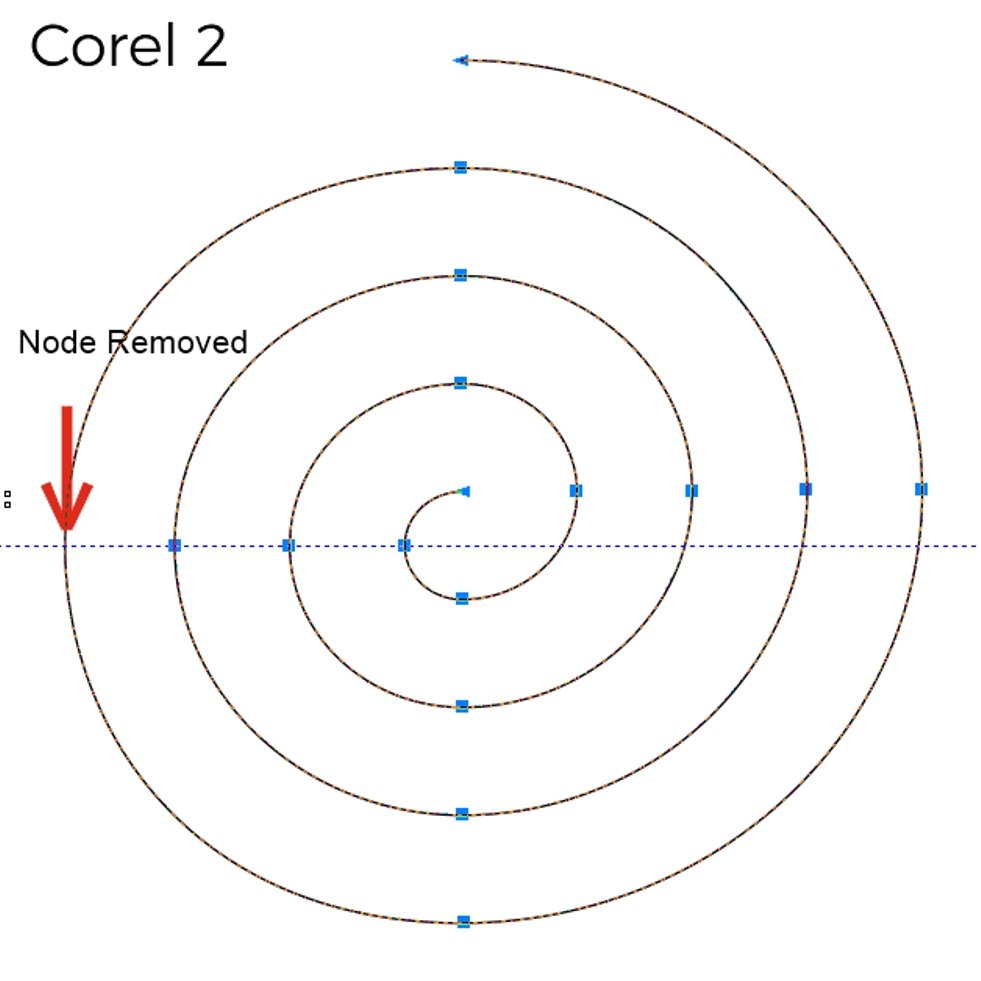
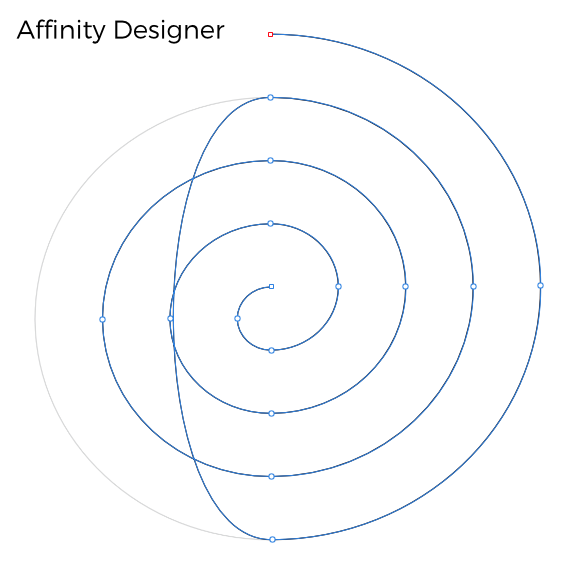
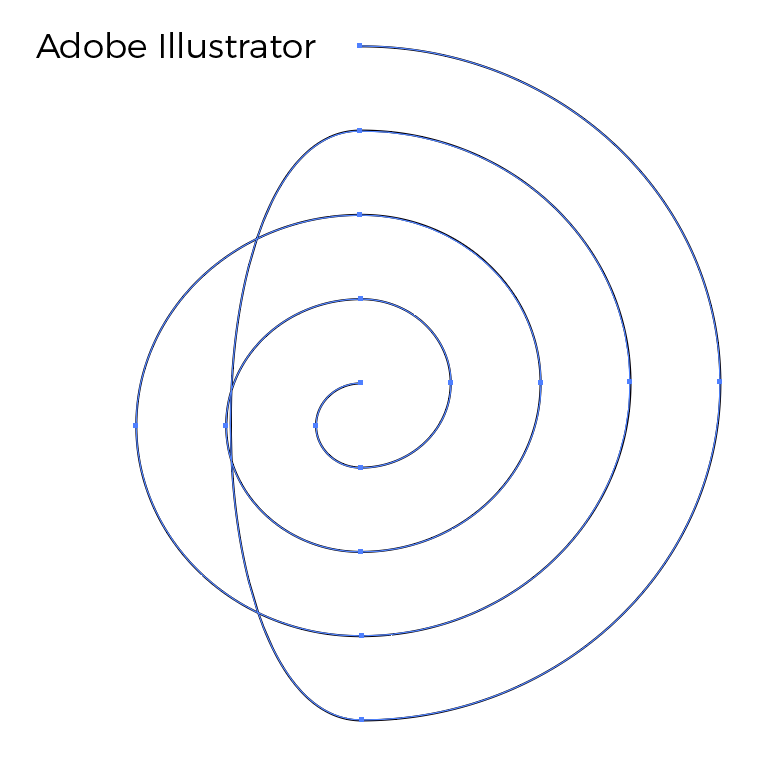
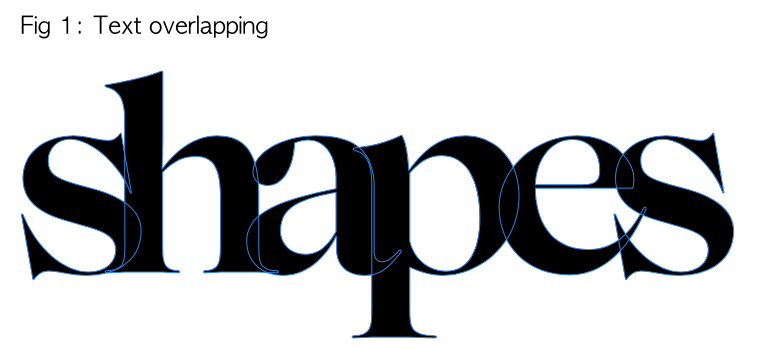
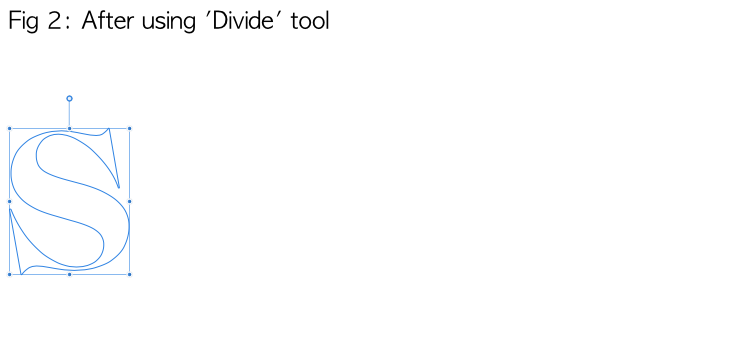

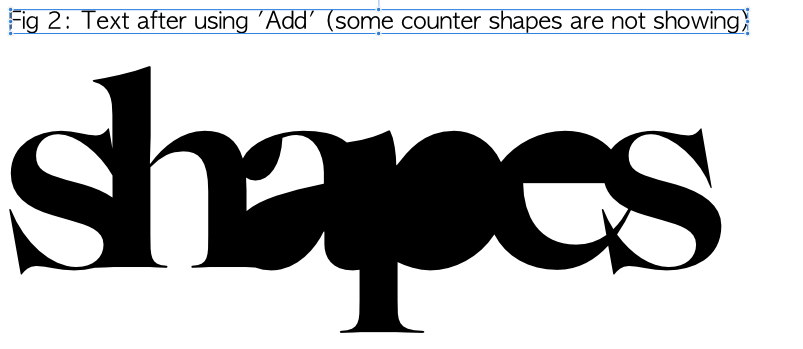

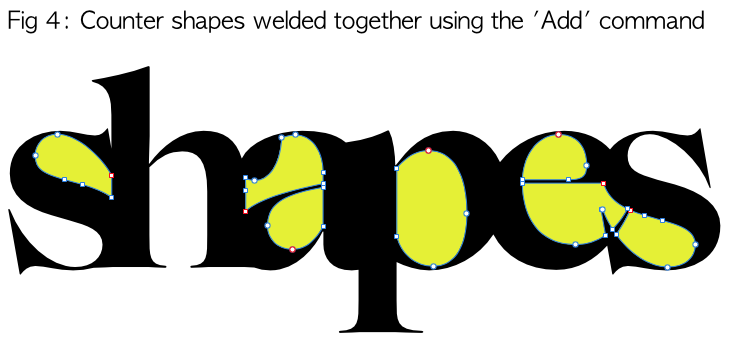
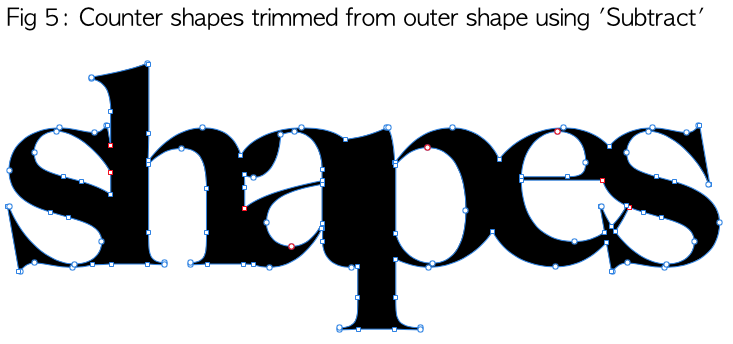
Word count in Affinity Publisher
in Feedback for Affinity Publisher V1 on Desktop
Posted
Exactly!
It's not the fact of whether it's entirely necessary or how good it is, it's the fact that it's just not there is a real head-scratcher.
If you tried to market a publishing/word processing app to someone and told them that it didn't have a word/character count, what do you think the response would be?